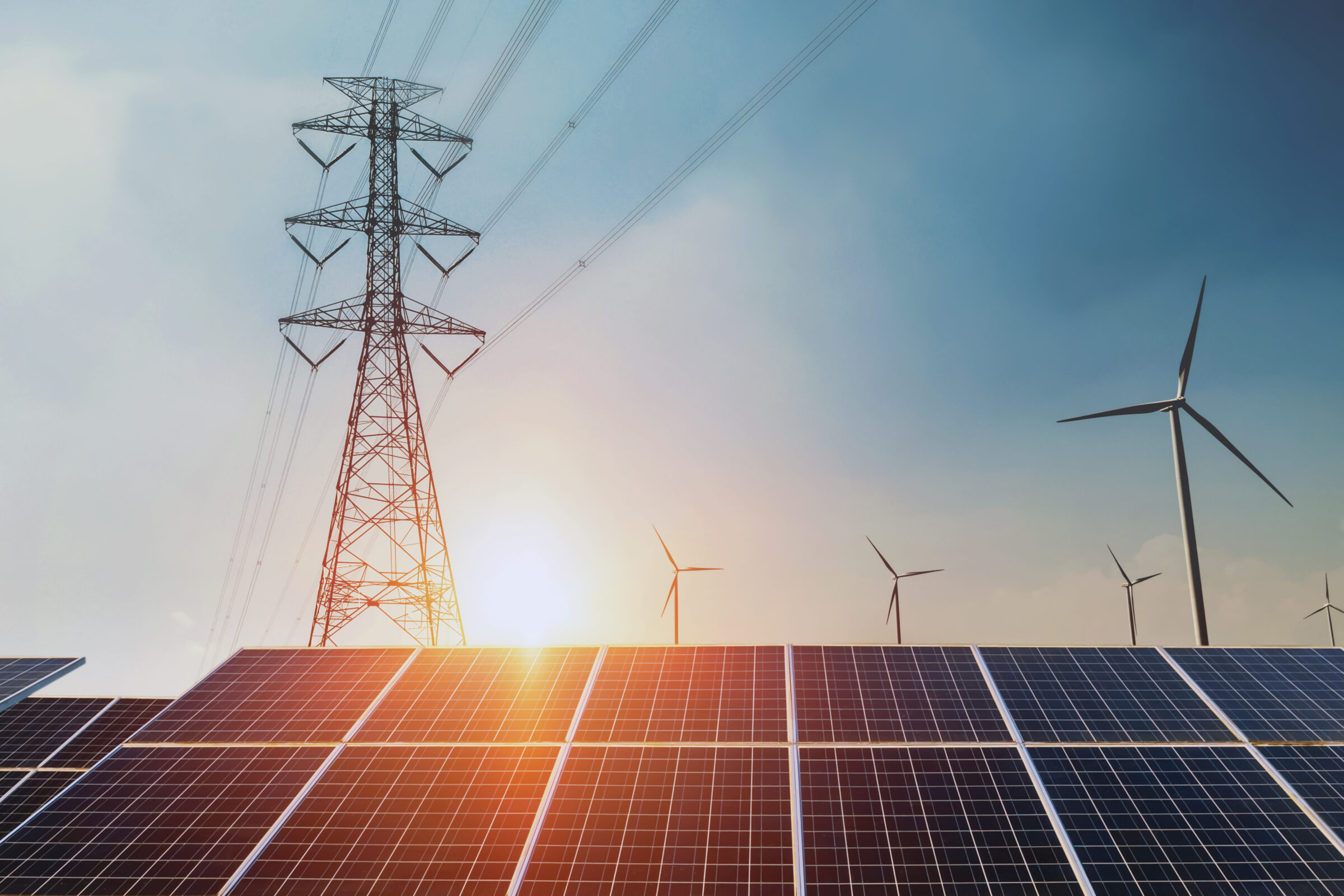- Grid Infrastructure
- Transmission & Power Markets
- Comments & Testimony
Joint Recommendations on the New York-Mid-Atlantic Proposed Corridor NIETC Designation
RECOMMENDATIONS OF PUBLIC INTEREST ORGANIZATIONS CONCERNING THE NEW YORK-MID-ATLANTIC PROPOSED CORRIDOR IN RESPONSE TO DEPARTMENT OF ENERGY’S INITIATION OF PHASE TWO OF THE NATIONAL INTEREST ELECTRIC TRANSMISSION CORRIDOR DESIGNATION PROCESS
Natural Resources Defense Council, Sustainable FERC Project, Earthjustice, Clean Air Task Force, National Wildlife Federation, American Council on Renewable Energy, Sierra Club, and National Audubon Society (together “Public Interest Organizations” or “PIOs”), submit these comments1 in response to the May 8, 2024 U.S. Department of Energy (DOE) Grid Deployment Office Initiation of Phase 2 of National Interest Electric Transmission Corridor (NIETC) Designation Process: Preliminary List of Potential NIETCs Issued Pursuant to Section 216(a) of the Federal Power Act (“Preliminary List”).2
I. The Department of Energy’s Transmission Needs Study Supports the Designation of the NY-NJ Proposed Corridor as a NIETC
Per Section 216(a)(2) of the Federal Power Act (FPA), a NIETC designation is appropriate in geographic areas currently experiencing or expecting electricity transmission capacity constraints or congestion that adversely affects consumers, where the designation is based on the findings of DOE’s National Transmission Needs Study (“the Needs Study”) or other relevant information.3 While the Needs Study supports the designation of NIETCs in many regions of the country, PIOs focus these comments on the preliminary designation of a NIETC in the New York-Mid-Atlantic Region (the “NY-NJ Proposed Corridor”).
The NY-NJ Proposed Corridor is an approximately 4-mile-wide, 12- mile-long north-south geographic area that includes multiple potential points of interconnection for new transmission capacity between New York and New Jersey, focused on the border between New York City and northern New Jersey.4 DOE notes that the corridor contains “multiple potential onshore points of interconnection” for offshore wind generation projects proposed or underway in the Atlantic Ocean, and for the potential offshore interlinks between ISO New England (ISO-NE), New York Independent System Operator (NYISO), and PJM Interconnection, LLC (PJM) identified by DOE and Bureau of Ocean Energy Management (BOEM) in the final Action Plan for Offshore Wind Transmission Development in the U.S. Atlantic Region – offshore links for which PIOs submitted Phase 1 comments.5
Designation of the NY-NJ Proposed Corridor as a NIETC is supported by the Needs Study, which cites multiple additional studies finding that an offshore wind networked system will provide greater benefits and will better facilitate the integration of offshore wind resources, compared with each offshore wind resource connecting to the onshore grid through a dedicated generator lead line.6 It also cites studies finding that proactive, coordinated transmission planning solutions to offshore wind integration can reduce onshore grid upgrade costs, increase reliability, and reinforce existing regional onshore grids, as well as improving efficiency and reducing environmental impacts by limiting the points of interconnection (POI), miles of transmission cables, and other physical infrastructure needed.7
The designation of a NIETC in this geographic area will play a key role in providing critical financial support for maximizing the efficient development of one of the most essential resources of the transitioning energy grid, as well as the continued federal coordination of the multiple state, local, and Tribal regulators, grid planners and operators, developers, affected communities, customers, and other stakeholders charged with the ongoing and increasingly rapid deployment of offshore wind generation.
There is an urgent need for federal action in coordinating and expediting offshore transmission development. Driven by state and federal offshore wind targets, DOE anticipates nearly 43 gigawatts (GW) of offshore wind capacity will be operating along the Atlantic Coast by 2040, and nearly 80 GW by 2050.8 The 2023 offshore wind project pipeline has more than 23 GW of capacity in the permitting stage or beyond, the majority of which is located off the coasts of New Jersey, New York, and Massachusetts.9 To support this energy transition, including changed generation profiles and growth in electrification driven by state policies, including in New York and New Jersey, as well as new large energy intensive economic development projects,10 more focused regional and interregional transmission planning is necessary. This includes improving current state and regional coordination efforts to spur a proactive, holistically-planned and networked offshore transmission system designed to accommodate known and anticipated long term needs—from energy policy requirements, market trends, and load growth, to region-wide winter peaks and extreme weather events that coincide with reduced reliability of fossil fuel resources.
As noted by a recent report by The Brattle Group, the siloed nature of state-based offshore wind development and a lack of existing interregional transmission planning has caused several urgent problems, including: long development timelines; ineffective use of limited corridors and interconnection points; inadequate interconnection processes; a lack of needed uniformity in addressing technical standards, HVDC integration, and transmission network designs; grid operation problems; a lack of coordination around BOEM permitting and leasing processes; and uncertainty around federal financial support.11 As the Brattle Report concludes, “[a]ctions taken in the next several years will not only impact the cost and environmental footprint of achieving OSW generation goals for the next decade, but will also pre-determine to a significant extent what is (or is not) possible by 2050.”12
DOE assistance can provide the holistic planning and coordination resources necessary to address the problems identified in the Brattle Report. Because states are not well equipped to solve these challenges on their own, federal guidance and support are needed. NIETC designation of the NY-NJ Proposed Corridor will unlock critical federal financing mechanisms – the Transmission Facility Program (TFP) authorized by the Infrastructure Investment and Jobs Act (IIJA)13 and the Transmission Facility Financing program authorized under the Inflation Reduction Act (IRA).14 These financing programs can also help offshore transmission under construction today to support state clean energy goals receive critical funding to help address inflationary costs threatening timely project construction.
The benefits of financial support and proactive planning oversight of a NIETC would unlock billions in transmission-related cost savings, greatly reduce marine transmission cable installations, significantly accelerate the achievement of offshore wind timelines, allow for the utilization of higher-capacity transmission cables that reduce costs and environmental impacts both on and offshore, improve the utilization and flexibility of offshore transmission infrastructure, and enable new transmission links addressing system constraints into New York City that reduce costs while increasing grid reliability and resilience.15
In short, NIETC designation of the NY-NJ Proposed Corridor as a NIETC is supported by the Needs Study and would provide a significant and needed boost to the successful, coordinated, and efficient development of the rapidly emerging Atlantic Coast offshore wind industry and would serve as a vital near-term stepping stone for a larger offshore wind transmission network that is critical to the national interest.
II. The NY-NJ Proposed Corridor Meets the Requirements Under 216(a) of the Federal Power Act
In addition to being supported by the Needs Study, designating the NY-NJ Proposed Corridor as a NIETC meets the relevant statutory factors under Section 216(a) of the Federal Power Act because (1) the end markets served by the economic corridor lack adequate or reasonably priced electricity; (2) economic growth in the corridor may be jeopardized by reliance on limited sources of energy and a diversification of supply is warranted; (3) the designation would improve energy security, serve the interest of national energy policy, and enhance national defense and homeland security; (4) the designation would enhance the ability of facilities that generate or transmit firm or intermittent energy to connect to the electric grid; and (5) there are multiple opportunities for the designation to maximize existing rights-of-way, and such a designation avoids and minimizes, to the maximum extent practicable, and offsets to the extent appropriate and practicable, sensitive environmental areas and cultural heritage sites.
First, DOE’s designation of the NY-NJ Proposed Corridor as a NIETC is needed because the end markets served by the economic corridor currently lack adequate or reasonably priced electricity16 and the designation would result in a reduction in the cost to purchase electric energy for consumers.17 Several regions are experiencing transmission congestion and constraints, contributing to portions of the Mid-Atlantic and New York experiencing persistently high wholesale electricity prices over the past 3-5 years.18 The wholesale electricity price differential between PJM and NYISO is also significant at just under $20/MwH.19 A NIETC designation can enable adequately priced electricity to reach consumers throughout the economic corridor.
Offshore wind will help lower the average wholesale price of electricity.20 Relying on offshore wind to assist in reducing consumer costs is necessary since median capacity expansion results show interregional transfer capacity must grow by 25 percent to meet future moderate load and clean energy growth, by 114 percent to meet moderate load and high clean energy growth, and by 412 percent to meet high load growth futures by 2035.21 The NY-NJ Proposed Corridor will help meet these needs by providing connections between NYISO and PJM without traversing congested terrestrial transmission areas, allowing consumers in these regions with high wholesale prices to access cheaper electricity markets.
Second, DOE’s designation of the NY-NJ Proposed Corridor as a NIETC is necessary because economic growth in the Corridor may otherwise be jeopardized by reliance on limited sources of energy, and a diversification of supply is needed.22 Over 80 percent of the U.S. population lives in crowded coastal areas, where space is limited for large-scale renewable energy. This is especially true in New York, where upstate boasts abundant renewable resources like wind, solar, and hydropower, generating a surplus of clean energy that exceeds local demand. However, the transmission infrastructure is inadequate to transport this surplus to downstate where the demand is significantly higher, particularly in New York City. As a result, the downstate region relies heavily on fossil fuels due to limited local generation capacity and urban density as the chart below demonstrates:23
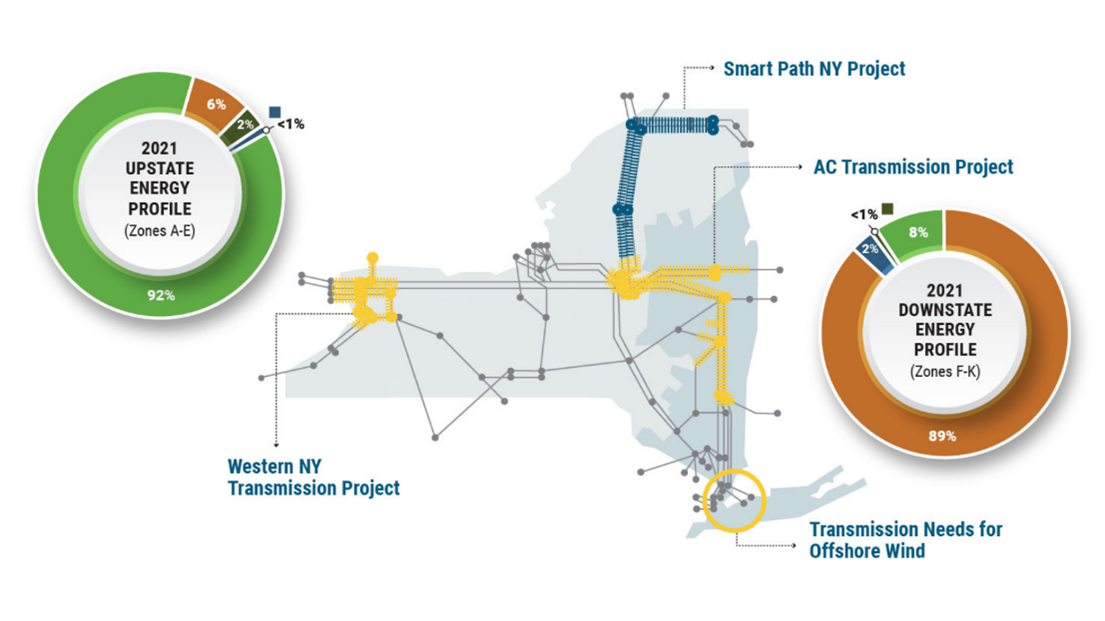
Offshore wind is especially important for New York City and Long Island as this region is one of the most constrained in the nation, which contributes to a correspondingly high energy burden for consumers in the region. In June 2023, the New York Public Service Commission (NY PSC) issued an Order Addressing Public Policy Requirements for Transmission Planning Purposes, stating that CLCPA requirements constituted a public policy requirement for transmission to support the injection of at least 4.77 GW of offshore wind energy into the New York City area.24 NYISO submitted comments during the PSC’s Notice of Proposed Rulemaking period on this Order to weigh in on the need for more offshore transmission capacity, highlighting “the development of wind resources off the Long Island coast under the CLCPA will drive the need for bulk transmission facilities offshore and in New York City and Long Island to facilitate the injection of offshore wind resources to the New York electric grid. Additional transmission capability continues to be necessary to deliver renewable resources to consumers throughout New York.”25
Both NYISO and the NY PSC identified the extremely constrained cable corridors available for offshore wind transmission into the New York City area, and the NYISO further reflected federal comments pertaining to transmission congestion and wholesale electricity costs, stating that it supported the PSC “identifying a Public Policy Transmission Need to supply offshore wind energy to NYC to maximize the efficient use of existing constrained cable corridors for the benefit of ratepayers.”26
Moreover, almost all of the region’s current generation resources are fossil fuel-based and located in disadvantaged communities.27 Current transmission constraints and forecasted increases in regional load have resulted in a NYISO determination that highly polluting peaker plants that were legally required to be shut down in May 2025 will instead be required to stay online run to meet reliability needs.28 While some new transmission will bring in hydroelectricity from Quebec, communities that are highly overburdened will continue to bear the harms from the continued use of aging fossil fuel plants until New York’s offshore wind resources come online.29
Third, the NY-NJ Proposed Corridor designation as a NIETC will support energy security30 and the interest of national energy policy,31 and will enhance national defense and homeland security.32 DOE has found a robust transmission system is critical to the country’s national security.33 Indeed, the reliability of the transmission system is integral to national security and declining investments in transmission threaten national security.34 Offshore wind can serve energy security by diversifying the energy supply and supplying as much as 24,000 GW of capacity, which is more than double the combined generating capacity of all U.S. power plants.35 This NIETC would facilitate the interconnection of that capacity onto the existing grid.
Fourth, the NY-NJ Proposed Corridor NIETC designation will enhance the ability of facilities that generate or transmit firm or intermittent energy to connect to the electric grid.36 The designation of the NY-NJ Proposed Corridor enables offshore wind projects generating intermittent energy to connect to the electric grid. States are the primary drivers of offshore wind development with state clean energy targets and offshore wind-specific procurement requirements.37 With NIETC designation, these states could more confidently issue requests for proposals to procure offshore wind, knowing that the financial incentives that accompany a NIETC designation would apply to the projects receiving procurement approval and aid developers in connecting their projects to the grid. Developers must pay the entire incremental cost of interconnection for both their own interconnection work and the utility’s work. NIETC designation can alleviate some of the associated costs, like power pricing locational features and landfall cost and availability and enhance the ability of projects to connect to the grid.
Fifth, the NY-NJ Proposed Corridor NIETC designation can provide multiple opportunities to maximize existing rights-of-way, and avoid and minimize, to the maximum extent practicable, and offset to the extent appropriate and practicable, sensitive environmental areas and cultural heritage sites.38 Every designation of a NIETC requires a National Environmental Policy Act (NEPA) review. The Council on Environmental Quality recently finalized revisions to the NEPA process to enhance public engagement that require DOE to consider more thoughtfully each of these elements and how DOE assesses these elements.39 Similarly, BOEM conducts environmental analysis and assesses multiple use conflicts prior to deciding whether to issue a right of way.40 In fact, BOEM can grant a non-exclusive right of way to create common offshore transmission corridors and minimize environmental impacts. An example of this is the non-exclusive Right-of-Way/Right-of-Use grant application submitted by Anbaric for a Southern New England Ocean Grid.41 The NY-NJ Proposed Corridor therefore meets all the statutory requirements of section 216(a).
III. State and Regional Clean Energy and Offshore Wind-Specific Requirements and Actions
Atlantic coast states have ambitious clean energy and offshore wind-specific goals driving the need for offshore transmission. In public documents, state governments, state regulators, and RTOs/ISOs in the region publicly cite these clean energy goals, existing and anticipated transmission constraints and congestion, ratepayer impacts, and dependence on fossil fuels as additional drivers behind the need for offshore transmission off the Atlantic coast. States have already shown initiative to work together to develop proactively planned and coordinated regional and interregional transmission solutions to reduce costs, impacts on environments and communities, and connect offshore resources to load centers most in need of clean electricity. All of these issues, which states currently are trying to address without NIETC designation, would be ameliorated by this designation. This NIETC designation for the NY-NJ Proposed Corridor would supercharge ongoing New York and New Jersey efforts by facilitating funding and coordination opportunities for these states.
A. New York and New Jersey Have Ambitious Offshore Wind Goals that the NY-NJ Proposed Corridor Would Help Facilitate
New York State has an ambitious goal of 70 percent of the state’s energy coming from renewable resources by 2030. Its Climate Leadership & Community Protection Act (CLCPA) set a mandate to procure 9 GW of offshore wind by 2035.42 By 2050, New York expects this number to rise to 20 GW.43 Funding for offshore wind projects in New York is handled through competitive solicitation processes run by the New York State Energy Research and Development Agency (NYSERDA) and overseen by the NY PSC, which issues specific capacity procurement levels and awards offshore wind renewable energy credits (ORECs) to winning developer bids.
New York’s offshore wind industry has struggled to get off the ground. New York’s first operational project is the 130 MW South Fork Wind Farm, which commenced operating in Long Island in December 2023. Two other projects totaling over 1.7 GW are currently in active development (Empire Wind 2 and Beacon Wind). Three further awards were made in October 2023 (Attentive Wind One, Community Offshore Wind, and Excelsior Wind) totaling over 4 GW.44 However, these three projects were later cancelled in April 2024 due to “technical and commercial complexities between provisional awardees and their partners,” largely due to GE Vernova’s offshore wind turbine product pivoting away from its initially proposed 18 MW turbine platform.45 This meant that project developers would have had to install more turbines to supply the amount of electricity they had contract to send to the state, raising their project costs. The three projects would have delivered 4 gigawatts of offshore wind to the state, amounting to almost half of New York’s 2035 goal. Moreover, the developers of Sunrise Wind and Empire Wind 1 rebid their contracts in January 2024 to account for the recent rises in interest rates and inflationary pressures that have recently roiled the U.S. offshore wind industry.46 Designating the NY-NJ Proposed Corridor as a NIETC would lower costs for the offshore wind industry in New York by streamlining permitting processes and reducing regulatory barriers, enabling faster and more efficient project development. By prioritizing critical transmission infrastructure, the designation would facilitate the efficient transport of offshore wind energy from the Atlantic coast to high-demand areas, attracting investment and supporting the industry’s growth in the state.
In 2020, New York passed the Accelerated Renewable Energy Growth and Community Benefits Act which accelerates progress in meeting the state’s clean energy goals and requires New York to conduct a power grid study to inform transmission system investments necessary to achieve these goals. As part of this grid study, the NY PSC issued an order establishing a coordinated grid planning process to conduct long term transmission planning that would ensure New York meets its climate and clean energy goals.47 This process is overseen by a stakeholder group that includes members from environmental and energy justice organizations.48 Designation of the NY-NJ Proposed Corridor could inform the NY PSC coordinated grid planning process to ensure NY does not overbuild transmission. The NY-NJ Proposed Corridor may also provide an avenue for federal and state agreement on what transmission system investments are necessary to meet New York’s clean energy goals.
NYSERDA has also explored different approaches for transmission and interconnection strategies for offshore wind, including direct radial versus backbone transmission. While its initial projects were direct radial transmission, it has stated that going forward it will continue to evaluate a backbone approach.49 The NY-NJ Proposed Corridor can inform the approaches adopted by NYSERDA by providing direction to one or more points of interconnection for the developers and the state.
In New Jersey, offshore wind renewable energy certificates were created under the 2010 Offshore Wind Economic Development Act.50 Subsequently, the Murphy Administration issued an Energy Master Plan to make sweeping reforms that would put the state on a path to achieve 100 percent clean energy by 2050 and set forth a comprehensive plan to address the decarbonization of the electric generation, transportation, and building sectors.51 As part of this reform, Governor Murphy issued a number of executive orders to implement the NJ OREC program, establish an Offshore Wind Strategic Plan and increase the offshore wind procurement mandate to 11 GW of offshore wind by 2040.52 The NY-NJ Proposed Corridor could align the NJ Offshore Wind Strategic Plan and NYSERDA’s research into transmission configurations and the grid study from the New York Accelerated Renewable Energy Growth and Community Benefits Act.
B. DOE’s Leadership in the Form of a NIETC Designation is Needed in this Instance Given the Demonstrated Record of Failed Interregional Projects in the NY-NJ Proposed Corridor
The NY-NJ Proposed Corridor sits at the seam of the NYISO and PJM RTO regions. Given differences in cost allocation methodologies and regulatory and policy regimes between RTOs, building new transmission capacity along seams has always been a challenge. While in theory the PJM/ISO-NE/NYISO Interregional Stakeholder Advisory Committee (IPSAC) would be the place where such offshore interregional projects could be discussed, planned, and built, it is ultimately unequipped in its current form to do so. This is primarily because of the shortcomings of Order No. 1000, which required that the interregional process include “a formal procedure to identify and jointly evaluate inter-regional transmission facilities.”53 However, rather than requiring actual joint planning, Order No. 1000 only mandated interregional coordination, where neighboring regions plan separately then compare results and jointly evaluate any potential interregional projects that arise.54 A key problem in implementing this approach has been that the agreements between RTOs/ISOs have a multistage approval process for interregional projects that requires a solution to go through a coordinated interregional process as well as two separate regional approval processes, the so-called “triple hurdle” problem. Because potential solutions must successfully meet three separate benefit-to-cost ratios, it is almost never the case that all three processes will result in one agreed upon solution. In addition, cost allocation for interregional projects is especially challenging given that regions have different approaches to cost allocation for projects that are within their borders, and because of the risk that one region may seek to unfairly impose costs on a neighboring region through this process. Given these inherent challenges, virtually no major interregional projects have been built since Order No. 1000 went into effect.
While eliminating existing barriers to interregional transmission projects can maximize net consumer benefits across regions and improve reliability and resilience in the face of increasing extreme weather events, these barriers to interregional planning make it virtually impossible to maximize net consumer benefits and have created a gap in investments near and across market seams, as regional planning authorities have shifted away from development along seams with neighboring regions and instead have focused primarily on local and regional investments and generator interconnection requests.55 Given these shortcomings inherent in the interregional coordination process mandated by Order No. 1000, the PJM/ISO-NE/NYISO IPSAC has not planned for or approved any major interregional projects in recent years. Thus, it is ill-equipped to be an appropriate forum for planning, building, and paying for these interregional projects.
Federal leadership in the form of a NIETC designation for the NY-NJ Proposed Corridor can provide needed direction and provide important financial incentives to developers in the PJM and NYISO regions. Historically, interregional transmission planning and actual power flows between PJM and NYISO have been minimal at best56 despite the many benefits afforded by interregional transmission.57 An interregional transmission project facilitated by the NY-NJ Proposed Corridor can provide a framework for equitable cost sharing, ensuring that the benefits and costs of new infrastructure are distributed fairly among stakeholders in both PJM and NYISO regions. This can lead to more economically efficient solutions that benefit consumers in both RTOs. Notably, DOE need not wait for states to sort out cost allocation and ex ante cost allocation deliberations as part of the Order No. 1920 long-term planning process. Rather, with these designations DOE can facilitate these decision-making processes and encourage collaboration.58 Such leadership can avoid further conflicts concerning interregional projects, like the Bergen-Linden Corridor where collaboration between New York and New Jersey fell apart due to disagreements regarding cost allocation obligations,59 which can lead to more economically efficient solutions that benefit consumers in both RTOs.
IV. DOE Should Ensure Ongoing Coordination Concerning New York’s Public Policy Transmission Need Process and Consider a Wider Area for Future NIETC Designations Concerning Offshore Wind in New York and New Jersey
PIOs commend DOE for identifying this proposed NY-NJ corridor as congested transmission area where ratepayers and developers alike would benefit significantly from federal funding opportunities and coordination. PIOs engaged in conversations with several offshore wind stakeholders with interests in or near the proposed corridor for feedback, and relay the following points for DOE’s consideration as it progresses through the NIETC designation process.
First, New York is currently undergoing its Public Policy Transmission Need (PPTN) process.60 Under this process, NYISO is actively seeking onshore and offshore transmission solutions and upgrades from developers that can deliver more than 4.7 GW of offshore wind generation into the New York City area. Developers were required to submit proposed solutions to the NYISO this month, and the NYISO is anticipated to finalize PPTN awards in 2026. It is likely that several projects proposed in the PPTN process will intersect with or interconnect into the land and water area covered by the NY-NJ Proposed Corridor. To ensure that the NIETC and PPTN processes are congruent and not duplicative, PIOs recommend (1) to the extent possible, DOE should maintain some flexibility in its specific corridor borders between 2024 and 2026 and remain open to amending its NIETC corridor designation to include the future 4.8 GW of onshore points of interconnection in the transmission corridor once these awards are finalized; and (2) DOE should ensure ongoing coordination, communication, and transparency between it, NYISO, and developers submitting PPTN projects.
Second, several stakeholders expressed an interest in extending the borders of the proposed NIETC corridor southward, some significantly into Brooklyn (Kings County) and Staten Island (Richmond County), with the rationale that the two southernmost boroughs will likely host the onshore transmission upgrades necessary for the New York PPTN. PIOs recognize the benefits of keeping corridors narrowly defined to both limit the geographic area subject to NEPA review and respect the applicant-driven nature of the NIETC process. If this proposed corridor is finalized as-is, DOE should continue to engage with developers active in the area to understand the pros and cons of NIETC designations outside of the proposed borders, particularly as the PPTN process advances. A wider area could then be considered in future NIETC designation processes.
V. The NY-NJ Proposed Corridor Appears to Overlap with Several Important Bird Areas
The current proposed corridor intersects with areas that the National Audubon Society has identified as important bird areas (IBAs),61 including sensitive areas surrounding the Meadowlands District.62 The proposed corridor is also within a very short distance of Central Park,63 Prospect Park,64 and the Palisades Interstate Park IBA.65
The Important Bird Areas (IBA) Program, administered by the National Audubon Society in the United States, is part of an international effort by BirdLife International66 to designate and support conservation efforts at sites that provide significant breeding, wintering, or migratory habitats for specific species or concentrations of birds. Sites are designated based on specific and standardized criteria and supporting data. Once more detailed geospatial data is available, we look forward to examining the extent to which these areas overlap and may offer additional comments recommending avoidance of these sensitive areas.
Outside of IBAs, risks to bird species vary across the proposed corridor. By combining five geospatial data layers relevant to avian transmission risk,67 mapping from the National Audubon Society shows areas of relative concern for birds posed by transmission infrastructure across the NY-NJ proposed corridor, with the highest concerns shown in red or orange.68 These areas correspond to collision mortality risk for vulnerable species groups, habitat displacement risks for priority species known to avoid transmission infrastructure, and habitat degradation risk, especially in areas recognized by the National Audubon Society as climate strongholds. These issues are explored in detail in the National Audubon Society’s recent Birds and Transmission report.69
To further minimize collision mortality of vulnerable species, PIOs support the anti-collision measures recommended in the Avian Protection Plan guidelines70 and the Bird and Bat Conservation Strategy (BBCS), specifically to follow Avian Power Line Interaction Committee recommendations in these and other areas for 1,000 feet on either side of a wetland or water feature. PIOs also recommend using ultraviolet (UV) lighting if needed to prevent further collision. Additional monitoring to verify effectiveness in these areas and ensure that additional areas do not need marking is needed, however. Still, preconstruction, annual operation and maintenance, and monthly raven monitoring are not frequent enough to detect mortalities before scavenging could occur. PIOs suggest installing automated collision detection systems like those used successfully on distribution lines in Hawaii.71
PIOs also recommend the avoidance of important bird areas, and where that is not possible, we recommend further analysis under the National Environmental Policy Act to understand the full suite of impacts to bird species. Furthermore, PIOs recommend that any line near IBAs implement the anti-collision measures in the Bird and Bat Conservation Strategy and, in areas where line marking occurs near Important Bird Areas and Wildlife Management Areas, monitor for avian collisions to inform adaptive management.
Further, during future environmental review, it is important to carefully assess potential species and habitat impacts that can occur during construction from cable laying. The siting of locations for undersea cables to make landfall is critical in avoiding impacts to bird species from displacement, loss of habitat, or disturbance. In general, projects should avoid near-shore cable laying during low tide during periods of nesting, staging, and migration (e.g., between mid-July and mid-September in southern New England) to minimize disturbing species like Common Terns (Sterna hirundo) and ESA-listed endangered Roseate Terns (S. dougallii). Projects should also avoid installation of export cable conduits during the nesting season to avoid disrupting beach-nesting birds e.g., Least Terns (Sternula antillarum) and the ESA-listed threatened Piping Plover (Charadrius melodus). If beach-nesting birds choose to nest in the area, then construction either needs to halt or avian construction monitors need to be hired to prevent mortality of chicks within 1000 m of the construction site. As additional details become available about the proposed siting, we look forward to offering detailed comments to avoid, minimize, and mitigate local habitat and species impacts.
VI. DOE Must Continue the NIETC Designation Process and Proposal Another Round of Potential NIETCs as Soon as Possible
The NY-NJ Proposed Corridor is an excellent first step to providing enough onshore transmission to allow states to meet their offshore wind goals and fulfilling the need and the statutory obligation for the region to rapidly decarbonize sources of electricity. However, this round of proposed NIETCs did not include more proposals that can inform and readily assist with the development of offshore wind along the Atlantic Coast. More corridors would substantially contribute to system reliability as offshore wind complements onshore renewables and increases resiliency of the grid.
As PIOs mentioned in response to the Phase 1 Information Submission Window, we also urge DOE to designate as a NIETC the geographic areas encompassing the four proposed interlinks connecting ISO-NE, NYISO, PJM, and the Carolinas (hereinafter referred to as “Proposed Corridor”) that were identified by DOE and the Bureau of Ocean Energy Management (“BOEM”) in the September 2023 Interim Action Plan for Offshore Wind Transmission Development in the U.S. Atlantic Region (the “Action Plan”).72 Designation of the corridor as a Proposed NIETC is supported by the Needs Study, which cites multiple additional studies finding that an offshore wind networked system will provide greater benefits and will better facilitate the integration of offshore wind resources compared with each offshore wind resource connecting to the onshore grid through a dedicated generator lead line.73 It also cites studies finding that proactive, coordinated transmission planning solutions to offshore wind integration can reduce onshore grid upgrade costs, increase reliability, and reinforce existing regional onshore grids as well as improving efficiency and reducing environmental impacts by reducing the number of necessary points of interconnection, miles of transmission cables, and other physical infrastructure.74 NIETC designation for the proposed offshore interlinks would significantly support the successful, coordinated, and efficient development of the nascent offshore wind industry. Current state and regional coordination efforts are failing to spur a proactively planned and networked offshore transmission system that will lower transmission system costs, reduce impacts on the environment and communities, and help Atlantic states reach their climate targets. Federal guidance and support are needed. NIETC designation will unlock critical federal financing mechanisms, attracting developers and countering inflationary costs that have threatened the timely construction of offshore wind projects.
Furthermore, interregional transmission is essential for all regions of the U.S. However, the current round of proposed NIETCs lacks an East-to-West and West-to-East corridor that could link the Western U.S. to the Midwest, as well as a Southeast designation. Establishing corridors for these regions is crucial to creating a more interconnected grid. Such corridors would guide and incentivize the involved regions and states to prioritize transmission infrastructure development.
Conclusion
PIOs appreciate the opportunity to provide recommendations in response to the Phase 2 Information Submission Window concerning DOE’s Grid Deployment Office Guidance on Implementing Section 216(a) of the Federal Power Act to Designate National Interest Electric Transmission Corridors, which is an important step toward developing transmission projects that are essential to mitigate climate change, meet the nation’s climate and clean energy goals, reduce congestion, increase reliability and resilience, and protect consumers, communities, and the environment.
Appendix A. Proposed NY- MidAtlantic Corridor and Planned and Existing Transmission Infrastructure
Map 1. The intersection of the proposed NY-NJ corridor, individual existing and planned transmission lines over 220 kV, and a representation of the density of planned and existing transmission lines over 230 kV (shown as a heat map).
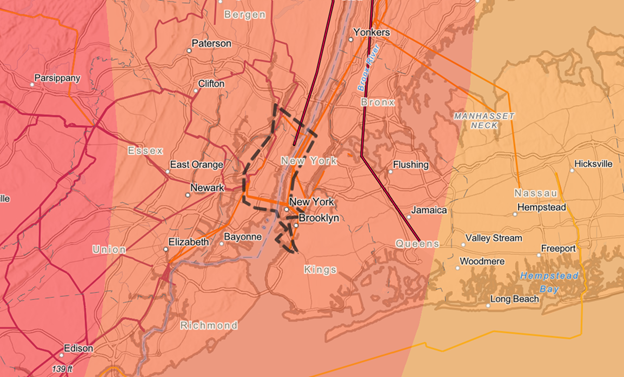
Appendix B. Intersection of Avian Species and Important Bird Areas with the Proposed NY- MidAtlantic Corridor
Maps 1-4 Intersections Between Important Bird Areas (shown in light blue) and the Proposed NY- MidAtlantic Corridor (shown in transparent gray) at various resolutions.


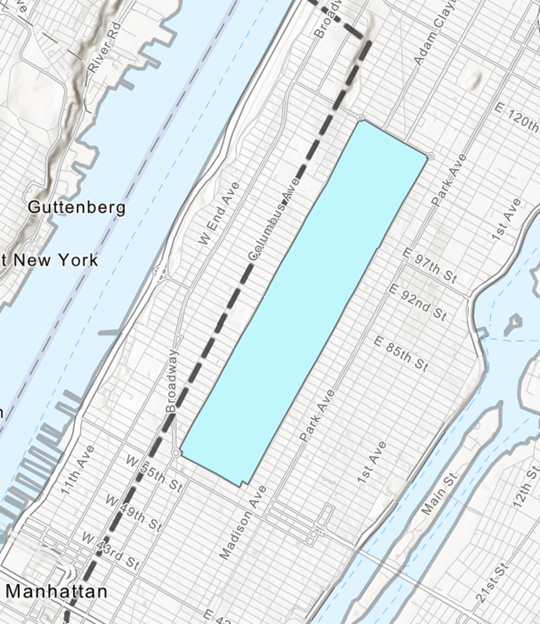
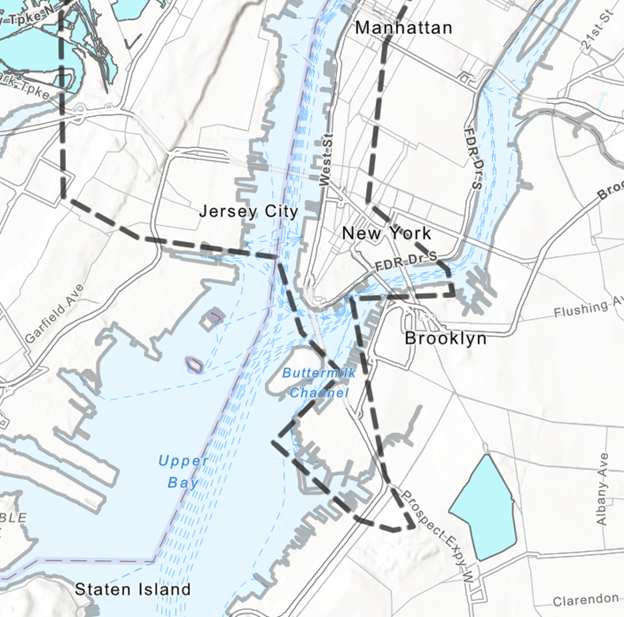
Maps 5-7 Relative Risks to Bird Species from Collision, Habitat Degradation, and Disturbance across the NJ-NY Proposed Corridor.75
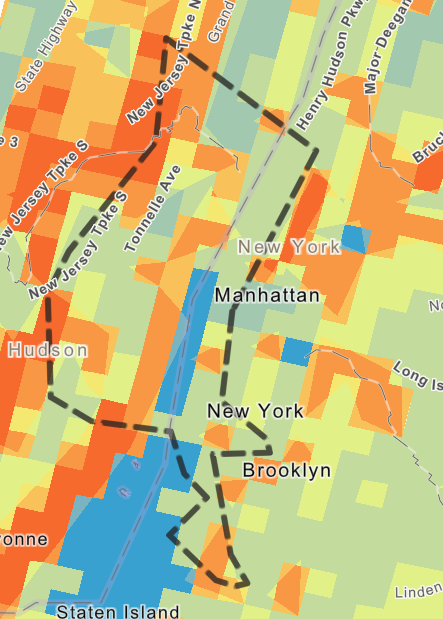
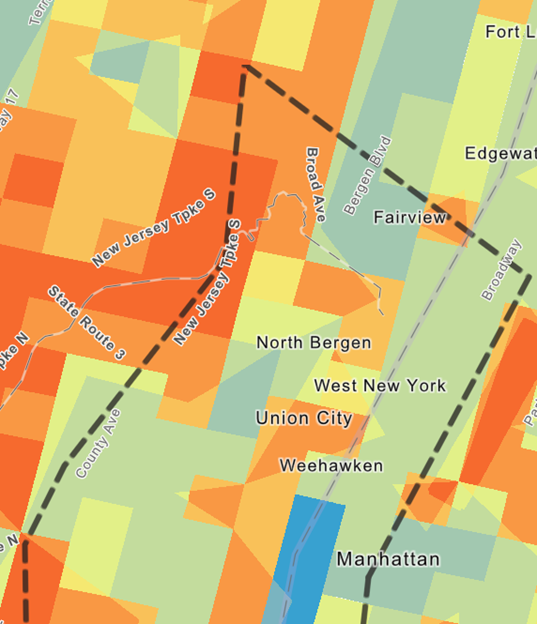
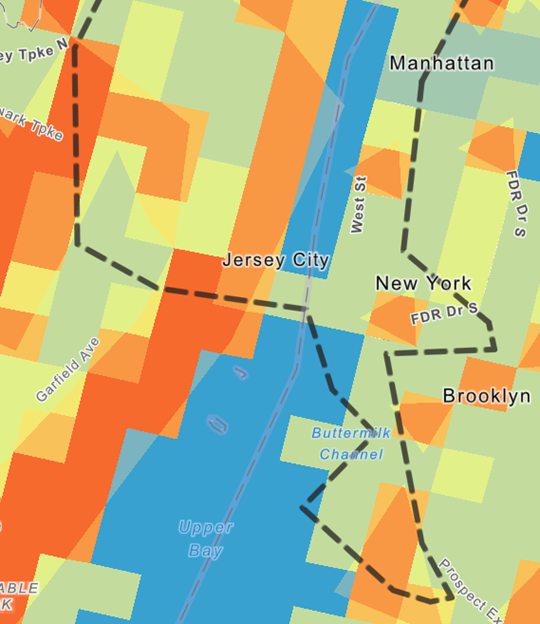
1 89 Fed. Reg. 909 (Jan. 8, 2024). PIOs note that the Final Guidance explicitly states that “interested parties” are eligible to submit information and recommendations about NIETC designation and that this term is defined as “any person or entity, including States and Indian Tribes, concerned with DOE’s exercise of its discretion to designate a geographic area as a NIETC.” As such, PIOs meet the definition of an interested parties and are thus eligible to submit such information. See Final Guidance at 43.
2 Several PIOS are signing onto other comments concerning other potential NIETCs identified in the Preliminary List.
3 Dept. of Energy, Grid Deployment Office, Guidance on Implementing Section 216(a) of the Federal Power Act to Designate National Interest Electric Transmission Corridors (Dec. 19, 2023) at 7 (“Final Guidance”), https://www.energy.gov/sites/default/files/2023-12/2023-12-15%20GDO%20NIETC%20Final%20Guidance%20Document.pdf.
4 DOE Phase 2 document at 13-15.
5 Id.
6 Id.
7 Id. at 82.
8 Dept. of Energy, Offshore Wind Market Report: 2023 Edition (Executive Summary) at 9, 28 (“OSW Market Report”), https://www.energy.gov/sites/default/files/2023-08/offshore-wind-market-report-2023-edition-executive-summary_0.pdf.
9 Id. at 10.
10 See, e.g., New York Independent System Operator, 2024 Power Trends Report (noting, among other things, higher demand due to electrification programs and economic development initiatives), https://www.nyiso.com/documents/20142/2223020/2024-Power-Trends.pdf/31ec9a11-21f2-0b47-677d-f4a498a32978.
11 Johannes P. Pfeifenberger, The Benefit and Urgency of Planned Offshore Transmission: Reducing the Costs of and Barriers to Achieving US Clean Energy Goals, The Brattle Group at 7-10 (Jan. 24, 2023) (“Brattle Study”), https://www.brattle.com/wp-content/uploads/2023/01/Brattle-OSW-Transmission-Report_Jan-24-2023.pdf.
12 Id. at 7.
13 Infrastructure Investment and Jobs Act of 2021 § 40106, 42 U.S.C. § 18713.
14 Pub. L. No. 117-169 (Section 50151).
15 Id. at 5-7.
16 16 U.S.C. § 824p(a)(4)(A).
17 16 U.S.C. § 824p(a)(4)(H).
18 Dept. of Energy, National Transmission Needs Study (Oct. 30, 2023) at ii (“Needs Study”), https://www.energy.gov/sites/default/files/2023-12/National%20Transmission%20Needs%20Study%20-%20Final_2023.12.1.pdf.
19 Id. at vi.
20 Offshore Wind Market Report: 2021 Edition, DOE at 2 (2021), https://www.energy.gov/sites/default/files/2021-08/Offshore%20Wind%20Market%20Report%202021%20Edition_Final.pdf.
21 Needs Study, supra n. 17, at vii.
22 16 U.S.C. § 824p(a)(4)(B)(ii).
23 Source: https://www.nyiso.com/-/new-transmission-investments-add-a-new-chapter-to-the-tale-of-two-grids-
24 https://www.nyiso.com/documents/20142/38447513/PSC-Order-Addressing-Public-Policy-Requirements-for-Transmission-Planning-Purposes-2023-06-22.pdf/1ae89bb7-075a-7502-4d03-3caa4f1e16f6 at 38.
25 https://www.nyiso.com/documents/20142/35671756/2023-02-21-NYISO-Comments-PPTN-2022-23-22E0633-CMPLT.pdf/f072e581-5cd2-5f21-c158-5322e61fef59 at 1-2.
26 https://www.nyiso.com/documents/20142/35671756/2023-02-21-NYISO-Comments-PPTN-2022-23-22E0633-CMPLT.pdf/f072e581-5cd2-5f21-c158-5322e61fef59 at 16.
27 See https://www.cleanegroup.org/publication/dirty-energy-big-money/.
28 NYISO, Short-Term Reliability Process Report: 2025 Near-Term Reliability Need Solution Selection (Nov. 20, 2023), https://www.nyiso.com/documents/20142/39103148/2023-Q2-Short-Term-Reliability-Process-Report.pdf/
29 https://www.nyiso.com/documents/20142/16004172/2023-Q2-STAR-Report-Final.pdf/5671e9f7-e996-653a-6a0e-9e12d2e41740.
30 16 U.S.C. § 824p(a)(4)(C).
31 16 U.S.C. § 824p(a)(4)(D).
32 16 U.S.C. § 824p(a)(4)(E).
33 Needs Study, supra n. 17, at ii.
34 Dept. of Energy, National Electric Transmission Congestion Study at 23 (Sept. 2020), https://www.energy.gov/oe/articles/2020-national-electric-transmission-congestion-study.
35 NREL, Strengthening America’s Energy Security with Offshore Wind (Apr. 2012), https://www.nrel.gov/docs/fy12osti/49222.pdf.
36 16 U.S.C. § 824p(a)(4)(F).
37 See supra section IIA.
38 See 16 U.S.C. § 824p(a)(4)(G).
39 National Environmental Policy Act Implementing Regulations Revisions Phase 2, 88 Fed. Reg. 49924 (July 31, 2023).
40 Bureau of Ocean Energy Management, Offshore Wind Transmission Framework at 6 (Jun. 15, 2021), https://www.boem.gov/sites/default/files/documents/renewable-energy/state-activities/BOEM-Transmission-Josh-Gange.pdf.
41 Anbaric Development Partners, Unsolicited Right-of-Way/Right-of-Use & Easement Grant Application Southern New England Ocean Grid Project (Nov. 18, 2019), https://www.boem.gov/sites/default/files/documents/renewable-energy/Anbaric-S-New-England-OceanGrid.pdf.
42 CLCPA bill text, https://legislation.nysenate.gov/pdf/bills/2019/S6599.
43 Dept. of Energy, Offshore Wind Market Report: 2023 Edition (Executive Summary) at 28, https://www.energy.gov/sites/default/files/2023-08/offshore-wind-market-report-2023-edition-executive-summary_0.pdf.
44 https://www.nyserda.ny.gov/All-Programs/Offshore-Wind/Focus-Areas/NY-Offshore-Wind-Projects.
45 See https://www.offshorewind.biz/2024/04/22/new-york-cancels-three-offshore-wind-projects/.
46 See, e.g., Bloomberg NEF, “Soaring Costs U.S. Offshore Wind Companies, Ruin Margins,” (Aug. 1, 2021), https://about.bnef.com/blog/soaring-costs-stress-us-offshore-wind-companies-ruin-margins/.
47 Order Approving a Coordinated Grid Planning Process at https://documents.dps.ny.gov/public/Common/ViewDoc.aspx?DocRefId={101C058A-0000-C45D-9CD3-A87E49DF7A99}.
48 Id.
49 https://www.nyserda.ny.gov/All-Programs/Offshore-Wind/Focus-Areas/Transmission-NY-Electricity-Grid.
50 New Jersey Senate No. 2036 (June 10, 2010) at https://pub.njleg.state.nj.us/Bills/2010/S2500/2036_R2.PDF.
51 Gov. Phil Murphy, Governor Murphy Unveils Energy Master Plan and Signs Executive Order Directing Sweeping Regulatory Reform to Reduce Emissions and Adapt to Climate Change at https://www.nj.gov/governor/news/news/562020/approved/20200127a.shtml.
52 NJ DEP, Offshore Wind Policy at https://dep.nj.gov/offshorewind/about/.
53 Order No. 1000 ¶¶ 435.
54 Order No. 1000-A ¶ 493.
55 See id. at 75-76.
56 See https://pjm.com/markets-and-operations/interregional-map.aspx.
57 Johannes P. Pfeifenberger, The Benefit and Urgency of Planned Offshore Transmission: Reducing the Costs of and Barriers to Achieving US Clean Energy Goals, The Brattle Group (Jan. 24, 2023) (“Brattle Study”), https://www.brattle.com/wp-content/uploads/2023/01/Brattle-OSW-Transmission-Report_Jan-24-2023.pdf.
58 Federal Power Act, 16 USC 824p (a)(2)(i)and (ii).
59 Kelly Andrejasich, NJ regulators take transmission project cost dispute to federal court, S&P Global (Mar. 27, 2020), https://www.spglobal.com/marketintelligence/en/news-insights/latest-news-headlines/nj-regulators-take-transmission-project-cost-dispute-to-federal-court-57777698.
61 See Appendix B, Maps 1-4.
62 See https://gis.audubon.org/portal/apps/dashboards/1742bc47f980490da9c23e23dc4d5e86#site=3169.
63 See https://gis.audubon.org/portal/apps/dashboards/1742bc47f980490da9c23e23dc4d5e86#site=2793.
64 See https://gis.audubon.org/portal/apps/dashboards/1742bc47f980490da9c23e23dc4d5e86#site=862.
65 See https://gis.audubon.org/portal/apps/dashboards/1742bc47f980490da9c23e23dc4d5e86#site=3172
66 Bird Life International Important Bird and Biodiversity Areas (IBAs) https://datazone.birdlife.org/site/ibacriteria. Accessed June 16, 2024.
67 For additional details on the data layers used to make these maps, see: https://audubon.maps.arcgis.com/home/item.html?id=7c67a04cdda249a393b562cae7a85e03
68 See Appendix B, Maps 5-7.
69 BATEMAN ET AL., AUDUBON’S BIRDS & TRANSMISSION REPORT: BUILDING THE GRID BIRDS NEED (August 2023), https://media.audubon.org/2023-08/BirdsAndTransmissionReport.pdf
70 Avian Protection Plan (APP) Guidelines, The Edison Electric Institute’s Avian Power Line Interaction Committee (APLIC) and U.S. Fish and Wildlife Service (USFWS), April 2005, https://www.aplic.org/uploads/files/2634/APPguidelines_final-draft_Aprl2005.pdf (last accessed June 19, 2024).
71 Marc S. Travers, et al., Power line minimization briefing document (Unpublished) Kaua‘i Endangered Seabird Recovery Project (KESRP), Pacific Cooperative Studies Unit (PCSU), University of Hawai‘i and Division of Forestry and Wildlife (DOFAW), State of Hawai‘i Department of Land and Natural Resources; See also Marc S. Travers et al., Spatial overlap in powerline collisions and vehicle strikes obscures the primary cause of avian mortality, 75 Journal for Nature Conservation (2023), https://static1.squarespace.com/static/65cff4adb166342b94a1d5e0/t/660b6c81feca02465008c406/1712024728936/travers-et-al-2023-spatial-powerline-collision-avian-mortality.pdf.
72 See U.S. Dept. of Energy and Bureau of Ocean Energy Management, An Action Plan For Offshore Wind Transmission Development in the U.S. Atlantic Region (Interim Draft Published Sept. 2023) (“Action Plan”), https://www.energy.gov/sites/default/files/2023-10/Atlantic-Offshore-Wind-Transmission-Plan-Report_October-2023.pdf.
73 Id.
74 Id. at 82.
75 For additional details on the data layers used to make these maps, see: https://audubon.maps.arcgis.com/home/item.html?id=7c67a04cdda249a393b562cae7a85e03
Join leaders from across the clean energy sector.

What will our next 20 years look like? Here’s the truth: they’ll be better with ACORE at the forefront of energy policy.
Shannon Kellogg
Amazon Web Services (AWS)
